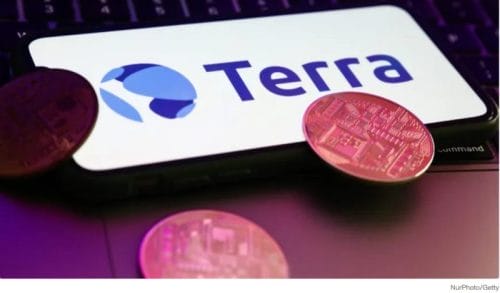By now you’re probably well aware that Terra (LUNA) and its attendant algorithmic stablecoin TerraUSD are dead in the water. LUNA’s blockchain has been halted directly with its price propped up a little above zero by people who haven’t gotten the memo, and TerraUSD is now trading at $0.12, having depegged from the US dollar on May 9.
I can’t figure out who is sadder: the doomscrolling tech-inept Cassandras foretelling the death of crypto (again) or the folks online who post on message boards that they’re buying the dip on a crypto that’s clearly in a death-spiral. And let’s not get it twisted. What we’ve seen from LUNA and TerraUSD over the past week hasn’t been a volatility driven market dip but a true death spiral.
So what happened?
“Ponzinomics”

A common objection to Bitcoin from folks who don’t know what they’re talking about is that it’s a ponzi scheme. These folks haven’t done any research and aren’t inclined too—likely scared off by overzealous hodlers and their weird ‘crypto is the future of money’ rants. I can relate. I’m a hodler and my eyes glaze over during those rants.
Bitcoin is not a ponzi scheme by definition. But algorithmic stablecoins have certain aspects to their mechanism which could be likened to that of a ponzi scheme. Forbes used the term Ponzinomics to describe TerraUSD and LUNA’s relationship in an article earlier this week, and it’s particularly apt, even if they didn’t actually explain it or go into detail.
So let’s have at it.
Algorithmic stablecoins were invented as a decentralized alternative to fiat or asset back stablecoins like USDT or USDC. The idea behind them is that companies like Tether or Circle (or others like Binance) have terrestrial offices, and are regulatory-reporting entities with assets that can be frozen or seized. Also, there’s the question of whether or not the company behind Tether actually has the collateral to back up the amount of coins they have in circulation.
In theory, you don’t have to worry about that with TerraUSD because if the system worked like it should have, it would maintain its peg. Except it didn’t work.
They’re called algorithmic because they’re supported by an on-chain algorithm that acts as an intermediary between supply and demand between the stable (UST) and another cryptocurrency (LUNA) that’s used or burned or bought or sold to help keep the stable at its peg.
We should draw a differentiation between algorithms as we understand them from say, Facebook or Twitter, and what they mean with crypto. In crypto, they refer to smart contracts, usually working in tandem with each other. This is a stripped-down description and there’s probably folks out there far more tech savvy than me screaming in frothing rage at their monitors right now, but that’s basically what it means. Essentially, it’s a smart contract that acts as the intermediary between the price function relationship of the two coins.
When supply of UST is too small and demand for it is too high, the price of UST goes above $1. To bring UST back to its peg, the Terra protocol lets users trade 1 USD of LUNA for 1 UST. This trade burns 1 USD of LUNA and mints 1 UST, which users can sell for 1.01 USD and pocket a profit of 1 cent. If you do this in large quantities, you can make some cash. It’s called arbitrage.
The reason I don’t own any LUNA (or UST) is because I couldn’t answer the following two questions.
- How functional is the smart contract/algorithm?
- What happens during a market downturn, when everyone is bailing out?
As with most things crypto there are competing claims as to what happened. Ponzi schemes require continual investment to maintain viable. If there’s no arbitrage opportunity because either the smart contract’s busted or everyone’s bailing on the coin as part of a larger market dump, then the effects could be catastrophic.
And they are.
UST started depegging on May 7 as large-volume withdrawals on Anchor, Terra’s largest decentralized platform, kicked off, according to Coindesk. This caused a domino effect on UST on Ethereum’s Curve Protocol, which is DeFi stablecoin liquidity hub, and also saw high volume withdrawals.
Others site the wider selloff presently effecting both stock-markets and crypto-markets courtesy of the Federal Reserve, inflation, interest rates, etc. Others suggest an attack but have little evidence.
Regardless of the actual cause, this suggests that at least at this iteration, algorithmic stablecoins aren’t ready for primetime. They couldn’t withstand the shock. Often with new technology (and remember – blockchain tech isn’t yet fifteen years old, let alone some of the newer stuff) it look great on paper but can’t withstand the shocks and bumps when in actual use.
Where was the algorithm in all this?
It couldn’t keep up with the demand for newly minted LUNA’s to offset the UDT price dip.
The effect was collapse.
Best laid plans

What sounds good on paper may not be so great in practice, and that’s a largely what’s wrong with plenty of crypto projects, and why you should wait a year or two to see if they can withstand the shocks.
LUNA couldn’t and that’s why the blockchain is halted.
Now big name exchanges are starting to delist both coins, including Binance and Coinbase.
The crash has also drawn regulatory scrutiny from SEC boss Gary Gensler and U.S. Treasury Secretary Janet Yellen, who called for more regulation in her annual testimony in front of the Senate Banking Committee suggesting she would be in favour of having stablecoins regulated by the end of the year.
Good.
Contrary to what the old guard crypto-types may tell you—regulation can only be a positive for the sector, and if it’s ever going to reach widespread acceptance and adoption, one may suggest that it’s even necessary.
—Joseph Morton

